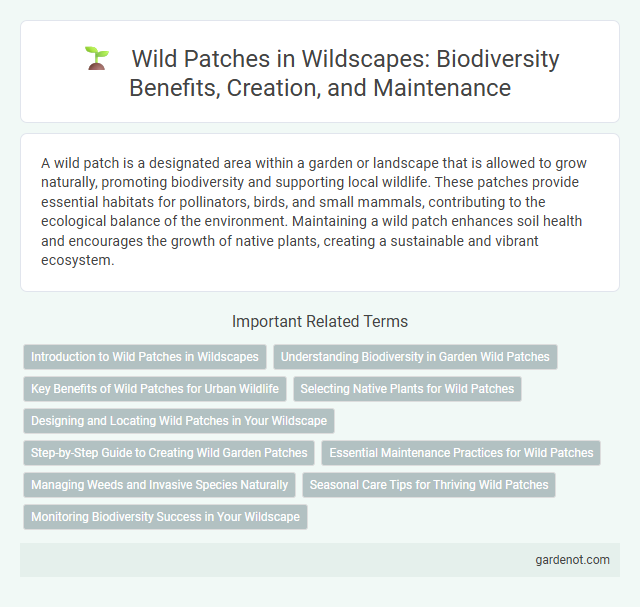A wild patch is a designated area within a garden or landscape that is allowed to grow naturally, promoting biodiversity and supporting local wildlife. These patches provide essential habitats for pollinators, birds, and small mammals, contributing to the ecological balance of the environment. Maintaining a wild patch enhances soil health and encourages the growth of native plants, creating a sustainable and vibrant ecosystem.
Introduction to Wild Patches in Wildscapes
Wild patches in Wildscape serve as essential ecological zones that promote biodiversity and habitat regeneration. These carefully managed areas support native flora and fauna by providing shelter, food sources, and breeding grounds. Maintaining wild patches enhances ecosystem resilience and contributes to the overall health of the landscape in Wildscape projects.
Understanding Biodiversity in Garden Wild Patches
Wild patches in gardens serve as vital reservoirs of biodiversity, supporting diverse plant species, insects, and small wildlife that contribute to ecological balance. These areas foster pollinators like bees and butterflies, enhance soil health through natural nutrient cycling, and provide habitats crucial for native bird and amphibian populations. Emphasizing the preservation and thoughtful management of garden wild patches promotes resilience against environmental stressors and supports urban conservation efforts.
Key Benefits of Wild Patches for Urban Wildlife
Wild patches in urban areas provide essential habitats that support biodiversity by offering food, shelter, and breeding grounds for native species. They enhance ecosystem services such as pollination and pest control, contributing to healthier urban environments. These green spaces also improve air quality and mental well-being for city residents by creating natural retreats amid urban landscapes.
Selecting Native Plants for Wild Patches
Selecting native plants for wild patches enhances local biodiversity by providing essential habitats and food sources for indigenous wildlife. Native species such as milkweed, goldenrod, and purple coneflower are well-adapted to the local climate and soil conditions, promoting sustainable growth and resilience. Incorporating a diverse mix of native plants supports pollinators, improves soil health, and strengthens ecosystem stability within wildscape areas.
Designing and Locating Wild Patches in Your Wildscape
Designing and locating wild patches in your wildscape involves selecting native plant species that support local wildlife and promote biodiversity. Position wild patches strategically near water sources or existing natural habitats to create wildlife corridors. Incorporate diverse vegetation layers to provide food, shelter, and breeding grounds for a variety of insects, birds, and small mammals.
Step-by-Step Guide to Creating Wild Garden Patches
Creating wild garden patches involves selecting native plants that support local wildlife, ensuring biodiversity and ecological balance. Prepare the soil by removing invasive species and enriching it with organic compost to promote healthy growth. Plant strategically in clusters to mimic natural habitats, water consistently during establishment, and avoid chemical pesticides to maintain a thriving wildscape.
Essential Maintenance Practices for Wild Patches
Essential maintenance practices for wild patches in Wildscape include regular monitoring for invasive species to preserve native biodiversity and promote ecosystem health. Soil health management through mulching and organic fertilization supports plant growth and resilience against pests. Implementing controlled watering schedules ensures optimal moisture levels without encouraging disease or runoff, enhancing the longevity of the wild patch.
Managing Weeds and Invasive Species Naturally
Wild patches thrive when managed through natural weed control methods such as mulching, hand weeding, and planting native species that outcompete invasive plants. Encouraging biodiversity supports ecological balance, reducing the need for herbicides and promoting healthy soil and pollinator habitats. Regular monitoring and early removal of invasive species prevent their spread while maintaining the wild patch's natural ecosystem integrity.
Seasonal Care Tips for Thriving Wild Patches
Wild patches require seasonal care to ensure vibrant growth and biodiversity. In spring, focus on soil conditioning with organic compost to boost nutrient levels, while summer demands regular watering and weed control to maintain moisture and prevent competition. Autumn calls for mulching and seed dispersal to protect roots and encourage natural regeneration through winter dormancy.
Monitoring Biodiversity Success in Your Wildscape
Monitoring biodiversity success in your Wildscape involves regularly tracking species diversity and abundance through systematic observations and data collection. Utilizing tools like remote cameras, insect traps, and native plant surveys helps quantify ecosystem health and identify trends over time. Consistent assessments enable adaptive management, ensuring your Wild patch continues to support and enhance local wildlife populations effectively.
Wild patch Infographic

 gardenot.com
gardenot.com